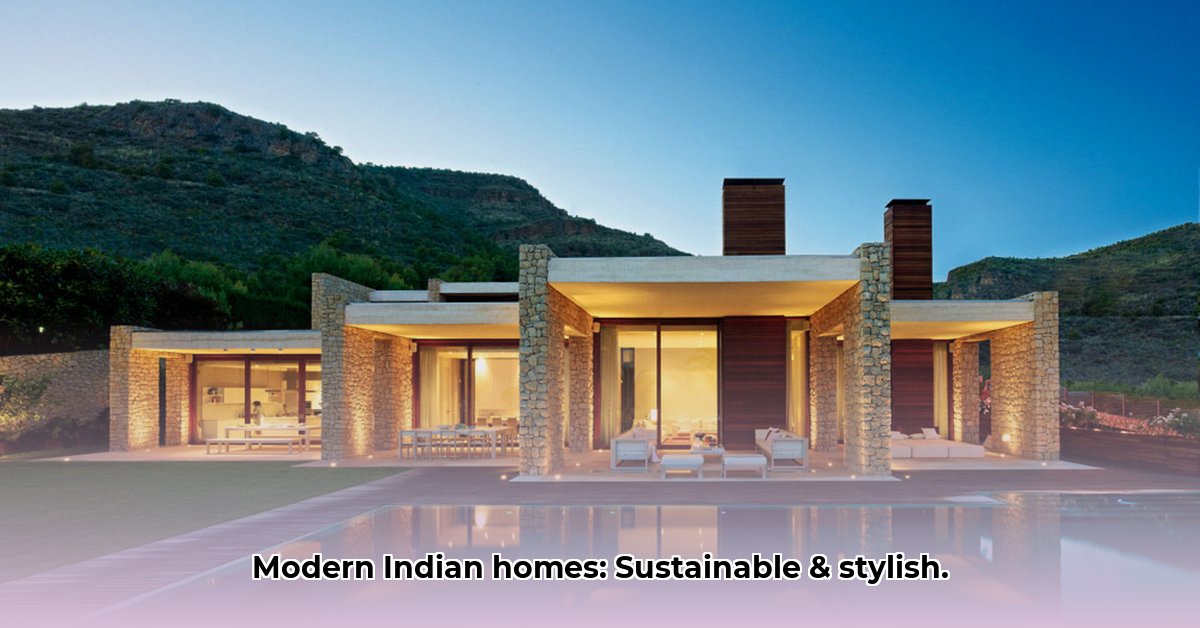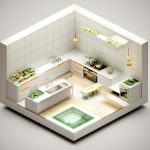Dreaming of building or renovating your home in India? Explore the exciting world of modern Indian house design. These stunning homes are not only beautiful but also smart and eco-friendly. From clever space-saving ideas perfect for city living to sustainable materials that are kind to the planet, discover how to create a home that’s both stylish and sustainable. For more inspiration, check out these modern Indian home designs.
Modern Indian Home Architecture: Fusing Tradition & Innovation
Building a home is a significant undertaking, and in India, the options are incredibly diverse! Modern house designs represent a captivating blend of traditional charm and cutting-edge concepts, resulting in homes that are both aesthetically pleasing and practical. Let’s delve into the trends shaping Indian home design, including popular styles, sustainability features, and space optimization techniques in architectural projects.
Architectural Styles: A Symphony of Timelessness and Freshness
Modern Indian houses showcase a variety of styles, seamlessly blending classic elements with contemporary twists. Minimalist designs are gaining popularity, characterized by clean lines, simple shapes, and a focus on light and airy spaces – ideal for urban living. Contemporary style features bold geometric designs, expansive windows, and modern layouts. The Indo-modern fusion style cleverly combines traditional Indian features like courtyards, jalis (latticed screens), and intricate carvings with modern layouts and materials, creating homes that feel both timeless and fresh.
Embracing Sustainability: Eco-Conscious Choices for Modern Homes
With growing environmental consciousness, sustainable features are becoming essential in modern Indian home design. Rainwater harvesting systems conserve water resources, and solar panels reduce reliance on fossil fuels. Designs that maximize natural ventilation reduce the need for air conditioning and save energy. Green roofs and walls provide insulation and improve air quality. These eco-conscious choices make for more comfortable and affordable homes in the long run. A study by the Center for Science and Environment found that homes with rainwater harvesting can reduce water bills by up to 30%.
Clever Space-Saving Solutions: Maximizing Urban Living
In India’s bustling cities, space is often limited, leading to creative space optimization. Multi-functional rooms, serving as both home offices and guest bedrooms, are becoming increasingly popular. Built-in storage solutions maximize every square foot, keeping things organized. Architects are designing compact yet functional layouts to meet the needs of modern families without sacrificing comfort or style. Foldable furniture, like wall-mounted beds and dining tables, are increasingly popular. Space optimization can also drastically improve the value of a home.
Material Choices: A Symbiotic Blend of Beauty and Sustainability
The materials used in a home have a profound impact on its aesthetics, durability, and environmental footprint. Modern Indian homes increasingly use locally sourced, eco-friendly materials. Bamboo, known for its rapid renewal, reduces the carbon footprint of construction. Recycled materials, such as reclaimed wood and recycled concrete, are also gaining traction, making homes both stylish and environmentally responsible. Using local stone minimizes transportation costs and supports local economies. Choosing sustainable materials not only helps the environment but often results in unique, characterful homes.
Evolving Trends: Meeting Changing Homeowner Needs
The needs and desires of Indian homeowners are constantly evolving, creating the rise of open-plan designs, dedicated home offices, and private outdoor spaces like balconies and terraces. These preferences are shaping how architects design homes to better cater to modern lifestyles and family interaction. “Homeowners are increasingly prioritizing flexible spaces that can adapt to their changing needs,” said [Arun Sharma], [Principal Architect] at [Vastu Architects], in a recent interview. “They also want homes that reflect their personal style and values.”
The Future of Indian Home Design: A Vision Ahead
The future of modern Indian homes points to an even greater emphasis on sustainability, energy efficiency, and smart home technology. The focus will remain on creating visually stunning spaces that are highly functional and adaptable to the evolving needs of Indian families. Passive solar design, which uses building orientation and shading to minimize heat gain in the summer and maximize it in the winter, will become more prevalent. Smart home technology will continue to modernize homes, offering features like automated lighting, climate control, and security systems. This involves a blend of tradition, technology, and a deep-seated commitment to sustainability for a more comfortable and eco-conscious future.
How to Optimize Space in Modern Indian Home Designs for Maximum Functionality
Key Takeaways:
- Modern Indian homes blend traditional aesthetics with contemporary space-saving solutions, optimizing living spaces.
- Sustainable materials and practices offer both cost and environmental benefits, enriching architectural design.
- Thoughtful design choices maximize functionality within limited square footage and provide smart home integration.
Architectural Styles and Space: Striking the Perfect Harmony
Several styles cater to modern Indian tastes. To accommodate both traditional and modern furniture, an Indo-modern fusion seamlessly blends traditional Indian elements with contemporary aesthetics. Minimalist designs maximize space with clean lines and uncluttered layouts. Open-plan living creates a sense of spaciousness and facilitates social interaction. The right style depends on your personal preferences and the available space, but a large space can be divided creatively using partitions or screens.
Smart Space-Saving Techniques: Turning Vision Into Reality
Clever design truly shines when it comes to how to optimize space in modern Indian home designs. Multi-functional furniture, like sofa beds or storage ottomans, doubles as seating and storage. Built-in shelving maximizes vertical space, minimizing floor clutter; consider space-saving designs, such as niches and alcoves, to create storage without taking up extra room. Sliding doors instead of traditional hinged doors save space and create a more fluid layout for homes. Wall-mounted desks and shelves free up floor space.
Adapting to Evolving Needs: Home Design In The Present
Modern Indian families have evolving needs, and these trends require dedicated spaces and smart storage solutions for possessions. Family gatherings and social interaction remain important, requiring adaptable living spaces, so understanding these needs helps architects create efficient and functional spaces. Flexible layouts that can be easily reconfigured to accommodate different activities are essential.
Space-Saving Designs for Modern Indian Apartments: Smart Solutions
Key Takeaways:
- Modern Indian apartments demand creative Space-Saving Designs for Modern Indian Apartments, maximizing every inch.
- Multi-functional furniture and vertical space are key, improving space design.
- Light colors visually expand rooms, and decluttering enhances both space and mental clarity for residents.
Maximizing Vertical Space: Optimizing Heights
Instead of spreading out horizontally, consider high shelving units, loft beds, and storage that reaches the ceiling. These are intelligent uses of wasted space. A wall-mounted fold-down desk eliminates the need for a bulky desk, which improves floor space. Utilize wall-mounted organizers to store items like books, plants, and decorative objects.
Multi-Functional Marvels: The Art of Dual-Purpose Furnishings
In Space-Saving Designs for Modern Indian Apartments, consider convertible sofas, ottomans with hidden storage, and coffee tables that lift to reveal surfaces. This approach maximizes functionality without excess, making it easier to manage space. For example, a living space can be converted for different utility. Murphy beds, which fold into the wall when not in use, are ideal for small apartments.
The Power of Light: Maximizing Impact
Light colors create an illusion of spaciousness and bounce light around, making any apartment appear more open and airy. Clever lighting design further amplifies this effect, adding to improvements in style. Sheer curtains allow natural light to filter through while maintaining privacy. Mirrors strategically placed can create the illusion of more space.
Sustainable Choices for a Greener Home: Long-Lasting Designs
Eco-conscious materials like bamboo and reclaimed wood are beautiful and durable, which adds to a design’s sustainability. Choosing locally sourced materials supports the community and reduces transportation emissions and can create more space. Cork flooring is a sustainable and comfortable option, especially in small apartments.
Eco-Friendly Building Materials for Modern Indian Homes and Sustainable Architecture
Key Takeaways:
- Modern Indian homes increasingly prioritize Eco-Friendly Building Materials for Modern Indian Homes to maintain sustainability.
- Sustainable materials offer environmental and economic advantages to society.
- Local resources like bamboo and reclaimed wood are gaining popularity for their eco-friendly building material.
Blending Tradition and Sustainability: Building For The Future
India’s architectural landscape is evolving with homes becoming more than just shelters—they’re reflections of our values. Creating stunning, modern homes while minimizing our environmental impact through Eco-Friendly Building Materials for Modern Indian Homes is becoming a common practice. Traditional materials like mud, lime, and stone are being re-embraced for their sustainability and aesthetic appeal.
Beyond Bricks and Mortar: Implementing Sustainable Practices
Sustainable building can be achieved through rainwater harvesting systems, solar panels, and natural ventilation to minimize the need for air conditioning. Thoughtful design choices reduce a home’s carbon footprint significantly, enabling modern architectural designs. Green roofs and walls provide insulation and improve air quality. Using energy-efficient appliances and lighting further reduces a home’s environmental impact.
The Future of Indian Homes: Eco-Friendly Materials
The future of Indian homes is green, with government initiatives and growing consumer awareness, which results in the increasing availability of sustainable materials. Architects and designers are embracing sustainable practices, creating beautiful homes that are both environmentally responsible and aesthetically pleasing. Innovations in sustainable building materials, such as bio-concrete and recycled plastic composites, are paving the way for a more sustainable future for Indian architecture.
- White On White Kitchen Backsplash: Is It Timeless? - November 20, 2025
- Backsplash Colors for White Cabinets: Find Your Perfect Match - November 19, 2025
- Backsplash Ideas for White Cabinets: Find Your Perfect Style - November 18, 2025










